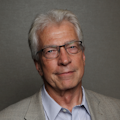When the Martian rover Perseverance and its extensive photonics payload was safely deposited in the Jezero Crater on February 18, 2021, I felt an unexpected and joyful jolt. My feelings couldn’t have matched the exuberance of NASA’s mission control scientists and engineers shown on screen leaping out of their seats and cheering when the safe landing was confirmed—but I was certainly caught up in the moment. And, surprising myself, I have been ever since.
Maybe the confluence of multiple news stories has sharpened my focus on Mars. The first spacecraft from the United Arab Emirates, Amal (Hope), entered Martian orbit on February 9 on a two-year mission to observe the planet’s atmosphere across all times and locations with a high-resolution imager and infrared and UV spectrometers. Amal was built at the University of Colorado Boulder and the Mohammed bin Rashid Space Centre in Dubai.
On February 10, the first Chinese spacecraft, Tianwen-1, also entered Martian orbit and, in late spring, will deposit a lander and rover on the surface. In addition to exploring the landing region for signs of ancient water or ice, the research will prepare the way for an ambitious sample-return mission and the long-term goal of sending humans to the planet.
Many of the instruments aboard Perseverance feel like old friends that we have described in Laser Focus World articles about the earlier Curiosity rover, which landed on Mars in 2012 and is still operating. The Perseverance Rover is an upgrade and carries more cameras and a new version of ChemCam known as SuperCam, which can perform both faster laser-induced breakdown spectroscopy (LIBS) and now Raman spectroscopy as well. The first helicopter flight on another world is planned soon so that the helicopter can help the rover safely move to a site that would have been favorable to ancient microbial life, if such life existed.
While these missions to Mars are exciting to follow, I think another reason for my engagement relates to the pandemic and the challenges to the global social fabric from so many directions. The exploration of Mars, combined with the incredible speed at which the vaccines for COVID-19 were developed, have given many of us a re-invigorating sense of human accomplishment and hope.
We can be grateful, as well, that the current political and environmental realities on Earth and Mars are not as apocalyptic as described in the classic 1950 science fiction work by Ray Bradbury, The Martian Chronicles. And it seems that claims of “fake news” have been less evident regarding the Mars missions than the widely spread conspiracy claims that the Apollo Moon landings were hoaxes staged by NASA.
This sense of hope leads me to recommend a lyrical memoir of a life in science: The Sirens of Mars: Searching for Life on Another World, by Sarah Stewart Johnson, who is a planetary scientist now at Georgetown University. Dr. Johnson weaves an engaging history of Mars science with her own story of growing up in Kentucky, then following a career that led from scrambling around a Hawaiian volcano to collaborating on Martian exploration at NASA’s Jet Propulsion Lab—in other words, doing science and looking for signs of microbial life on Mars.
My sense of wonder at the world may have been waning a bit in the past few years. So thank you, Dr. Johnson, and all your colleagues, and all those scientists, engineers, technicians, and staff who are keeping the wonder alive for us all.
About the Author

Conard Holton
Conard Holton has 25 years of science and technology editing and writing experience. He was formerly a staff member and consultant for government agencies such as the New York State Energy Research and Development Authority and the International Atomic Energy Agency, and engineering companies such as Bechtel. He joined Laser Focus World in 1997 as senior editor, becoming editor in chief of WDM Solutions, which he founded in 1999. In 2003 he joined Vision Systems Design as editor in chief, while continuing as contributing editor at Laser Focus World. Conard became editor in chief of Laser Focus World in August 2011, a role in which he served through August 2018. He then served as Editor at Large for Laser Focus World and Co-Chair of the Lasers & Photonics Marketplace Seminar from August 2018 through January 2022. He received his B.A. from the University of Pennsylvania, with additional studies at the Colorado School of Mines and Medill School of Journalism at Northwestern University.
